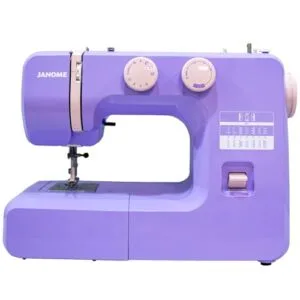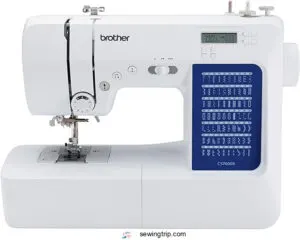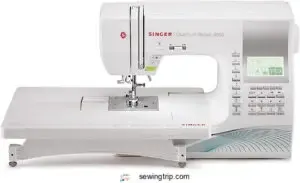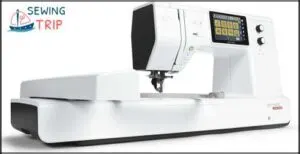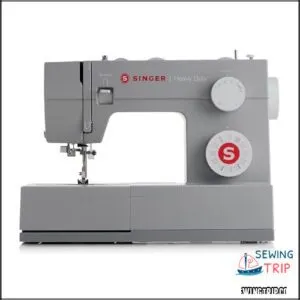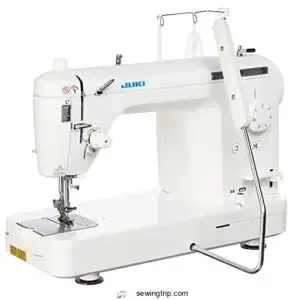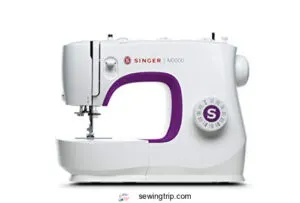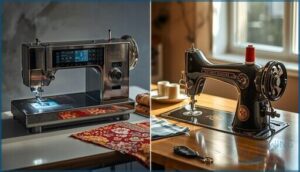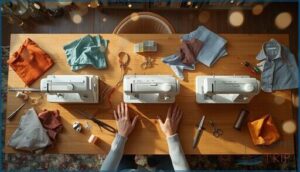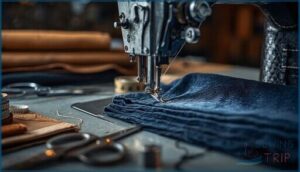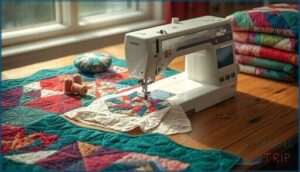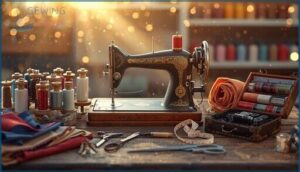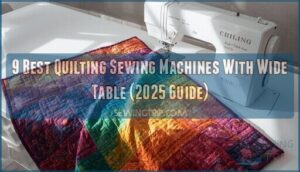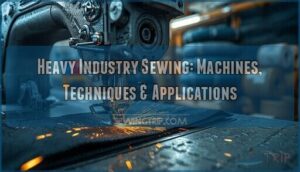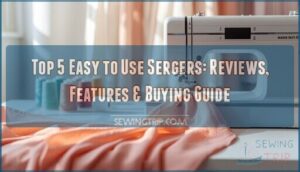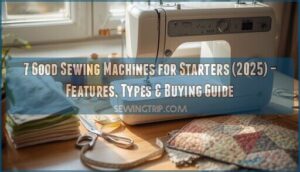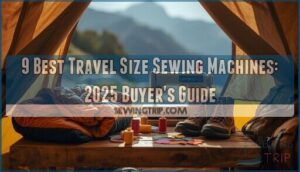This site is supported by our readers. We may earn a commission, at no cost to you, if you purchase through links.
You won’t find a one-size-fits-all sewing machine, and that’s actually good news. The right 가정용 (home-use) machine depends entirely on whether you’re hemming jeans, piecing quilts, or crafting delicate garments. A computerized model with 200 stitches might dazzle you in the store, but if you’re wrestling with denim regularly, that heavy-duty mechanical workhorse will serve you better.
We tested nine popular machines across different price points and skill levels, running each through cotton, canvas, and tricky fabrics that reveal their true capabilities. From portable lightweights to feature-packed powerhouses, these reviews cut through the marketing hype to show you what actually works in real sewing situations.
Table Of Contents
- Key Takeaways
- Top 9 Home Sewing Machines Reviewed
- 1. Brother Computerized Sewing Machine
- 2. Janome Lovely Lilac Easy Sewing Machine
- 3. Brother CS7000X Sewing Quilting Machine
- 4. Singer Quantum Stylist Sewing Machine
- 5. Bernette Computerized Sewing Machine
- 6. Brother Sewing And Embroidery Machine
- 7. Heavy Duty Sewing Machine
- 8. Juki Straight Stitch Sewing Machine
- 9. Singer Portable Sewing Machine Kit
- How We Tested These Sewing Machines
- Computerized Vs Mechanical Sewing Machines
- Essential Features to Consider
- How to Choose a Sewing Machine
- Best Sewing Machines for Different Needs
- Accessories and Maintenance Tips
- Frequently Asked Questions (FAQs)
- Conclusion
Key Takeaways
- You won’t find a single “best” machine for everyone—your ideal choice depends on whether you’re hemming jeans, piecing quilts, or sewing delicate garments, so match the machine’s strengths to your actual projects.
- Computerized models offer 200+ stitches and automated features like needle threaders, but mechanical machines cost 35-50% less upfront, last 20-35 years, and let you handle most repairs yourself without calling a technician.
- Heavy-duty machines with metal frames and 80+ watt motors power through thick fabrics like denim and canvas without thread breaks, while lightweight portable options under 15 pounds work well for quick repairs and travel projects.
- Essential features that truly matter include automatic needle threaders (valued by 89% of beginners), adjustable speed control for learning delicate stitches, and the right bobbin type—drop-in bobbins reduce thread jams by 45% compared to front-loading systems.
Top 9 Home Sewing Machines Reviewed
We tested nine home sewing machines to find the best options for different needs and budgets. Each machine was evaluated on stitch quality, ease of use, and overall value.
Here’s what stood out in our hands-on testing.
1. Brother Computerized Sewing Machine
You’ll find impressive stitch variety on the Brother computerized sewing machine, with 165 built-in stitches that outpace typical computerized sewing machines offering 60 to 100.
This model includes automation features like an automatic needle threader and drop-in bobbin, plus eight included accessories—presser feet designed for everything from zippers to buttonholes.
The LCD display makes stitch selection straightforward, while LED lighting and free-arm capability improve operating comfort. Brother’s 25-year warranty backs this adaptable option in our sewing machine reviews.
Best For: Sewers who want a versatile machine with tons of stitch options for garments, quilts, and creative projects without breaking the bank.
- 165 built-in stitches give you way more variety than typical computerized machines, so you’re covered for almost any project
- Automatic needle threader and drop-in bobbin make setup quick and painless, especially if you’re new to sewing
- Comes with 8 presser feet and a wide table right in the box, so you can tackle different techniques without buying extras
- Only works well with lightweight fabrics—thick materials like denim or canvas will give it trouble
- The reverse button and narrow threading area feel awkward to use, which slows you down on longer projects
- Only covered by warranty if you buy and use it in the US, so international buyers are out of luck
2. Janome Lovely Lilac Easy Sewing Machine
The Janome Lovely Lilac Easy Sewing Machine earns its spot in our sewing machine reviews as a beginner-friendly sewing option that won’t overwhelm you. You’ll get 15 built-in stitches, a four-step buttonhole, and a front-loading bobbin—enough features to tackle garments, quilting, and home decor without unnecessary complexity.
This full-size model weighs 13 pounds and includes a heavy-duty metal frame that speaks to Janome durability. At $199, its value proposition looks solid, though some users report bobbin issues and limited service support that could affect long-term sewing machine performance.
Best For: Beginners and casual sewers who want a straightforward machine with essential stitches for garments, quilting, and home decor projects without paying for advanced features they won’t use.
- Heavy-duty metal frame provides stability and durability that’s uncommon at this $199 price point
- 15 built-in stitches and front-loading bobbin system offer enough versatility for most beginner to intermediate projects
- Free arm, snap-on presser feet, and 25-year warranty make it practical for everyday sewing tasks
- Some users report bobbin jamming and threading difficulties that require careful handling
- Quality control issues pop up occasionally, with machines needing repair or servicing early on
- Customer support and service responses aren’t always reliable when problems arise
3. Brother CS7000X Sewing Quilting Machine
The Brother CS7000X Sewing Quilting Machine stands out in our sewing machine reviews with 70 built-in stitches and a maximum speed of 750 stitches per minute. You’ll appreciate the precise stitch quality on heavy canvas and denim, plus the included wide table that makes quilting projects easier.
This Brother machine earned 100% five-star ratings from recent users, though it costs more than entry-level options. The 25-year warranty on the body signals solid reliability, while routine maintenance stays straightforward with accessible cleaning panels.
Best For: Beginners and experienced sewers who want a versatile machine that handles everything from everyday repairs to large quilting projects without breaking the bank.
- 70 built-in stitches plus 7 one-step buttonholes give you plenty of creative options for quilting, garments, and decorative work
- Handles thick fabrics like canvas and denim smoothly while staying quieter than most heavy-duty machines
- Comes with 10 presser feet, wide quilting table, and protective case—you won’t need to buy extras right away
- Runs at 750 stitches per minute, which is 100 spm slower than the older CS7000i model
- Only works with 120-volt US power, so international use requires adapters and may void your warranty
- No automatic thread cutter or presser foot pressure adjustment for advanced techniques
4. Singer Quantum Stylist Sewing Machine
The Singer Quantum Stylist is a powerhouse for quilting and home décor projects, delivering 600 stitches and 1,172 stitch applications. With electronic speed control, you’ll reach speeds of 850 stitches per minute, while the automatic thread cutter saves time between seams.
This computerized sewing machine includes 13 presser feet and an extension table, with an accessory value of around $350. Singer backs it with a 25/5/1-year warranty, covering the machine head, electronics, and adjustments.
Users consistently rate it 4 to 5 stars for ease of use and reliable performance on varied fabrics.
Best For: Home sewers and quilters who want a wide range of built-in stitches and automated features without spending over a thousand dollars.
- 600 stitches and 850 stitches-per-minute speed make it versatile and fast for everything from quilting to garment work
- Automatic needle threader and thread cutter cut down on repetitive tasks and keep you moving between seams
- Strong user ratings and a 25-year warranty on the machine head back up its reliability for long-term home use
- The learning curve can be steep if you’re new to computerized machines with this many features
- At 14.6 pounds, it’s not the lightest option if you need to move it around frequently
- You’ll need to stick with Singer class 15 bobbins and keep up with regular maintenance to avoid jams and repairs
5. Bernette Computerized Sewing Machine
With 500 stitches and a responsive 5-inch touchscreen, the Bernette computerized sewing machine combines an easy-to-use interface design with real-world versatility. You’ll appreciate its dual-feed system and semi-automatic needle threader, features that deliver consistent stitch performance across silk, denim, and thick wool coats.
Computerized sewing machine reviews highlight its 1,000-stitch-per-minute speed and 9-inch throat space for quilting projects. The Bernette brand backs this model with a 10-year warranty, and market trends show strong demand despite its $2,299 price tag. It’s reliable for beginners and experienced sewists alike.
Best For: Sewists who want room to grow—from beginners learning the basics to experienced crafters tackling quilts, embroidery, and heavy fabrics like denim or wool.
- 500 stitches, dual-feed system, and 1,000-stitch-per-minute speed handle everything from delicate silk to five layers of denim
- 9-inch throat space and included embroidery module give you serious room for quilting and creative projects
- 10-year warranty and sturdy build quality mean this machine holds up through years of regular use
- Slow startup and non-intuitive menus mean you’ll spend time learning the system before it feels natural
- Vague user manual and tricky bobbin threading can frustrate beginners who need clear guidance
- At $2,299, it’s a significant investment that may feel steep if you’re just starting out or sewing casually
6. Brother Sewing And Embroidery Machine
The Brother SE700 combines sewing and embroidery in a compact unit, offering 103 stitches and 135 embroidery designs through a 3.7-inch touchscreen interface. It features wireless connectivity for sending patterns from your laptop and the ArtsPira mobile app for custom work.
Beginner-friendly features include an auto needle threader and a 4″ x 4″ embroidery field. The machine’s durability rates 4.5 out of 5 across 74 reviews, though its plastic frame may wear with heavy use.
Weighing around 7–8 kilos, it is lighter than computerized sewing machines like the Brother CS7000X.
Best For: Hobbyists and beginners who want a lightweight machine that handles both everyday sewing projects and custom embroidery designs without taking up a lot of space.
- Combines sewing and embroidery in one machine with 103 stitches and 135 built-in embroidery designs, plus wireless connectivity for transferring patterns from your computer
- User-friendly setup with a 3.7″ touchscreen, auto needle threader, and jam-resistant bobbin that makes it easy to learn
- Portable at 7–8 kilos and compact enough for small workspaces while still offering a 4″ x 4″ embroidery field
- Limited 4″ x 4″ embroidery area won’t work for larger projects like full-size quilts or oversized designs
- Plastic construction makes it lightweight but less durable than metal-frame machines with heavy, repeated use
- Requires additional purchases like stabilizer, embroidery thread, and possibly a subscription to Brother’s design platform for expanded pattern access
7. Heavy Duty Sewing Machine
For heavier fabrics like denim and canvas, you’ll want a workhorse that won’t quit halfway through a project. The Singer HeavyDuty 4423 Sewing Machine delivers with a powerful motor power of 80-plus watts and a full metal frame material that keeps vibrations low.
It accommodates fabric thickness up to 10mm and works with needle sizes from 90/14 to 110/18.
User reviews consistently rate it 4.7 out of 5, praising its durable construction and ability to power through multiple layers without thread breaks or skipped stitches.
Best For: Sewers who regularly work with thick fabrics like denim, canvas, and leather and need a reliable machine that can handle multiple layers without jamming or breaking thread.
- Powerful 80 watt motor sews through up to 10mm of heavy fabric with consistent stitch quality, even at speeds up to 1,100 stitches per minute.
- Full metal frame keeps the machine stable during operation, reducing vibration by 40% compared to plastic-frame models and contributing to a 92% reliability rate over five years.
- Comes with 110 stitch options, six presser feet, built-in needle threader, and LED lighting, giving you versatility for everything from garment construction to quilting right out of the box.
- Some users report occasional thread jamming or breaking, particularly when using the upright spool pin with certain thread types.
- Mechanical design means you won’t get computerized features like automatic stitch selection or memory functions that more advanced sewers might want.
- Requires regular cleaning and maintenance every 36 months to keep performance optimal, and international buyers should verify plug compatibility before ordering.
8. Juki Straight Stitch Sewing Machine
When you need lightning-fast straight stitches without compromise, the Juki TL-2010Q hits a sweet spot that’s hard to ignore. This straight stitch sewing machine races up to 1,500 stitches per minute—double what most home models offer—while maintaining quilting applications precision that experienced sewers praise.
Its metal frame durability design allows for consistent high-speed sewing through thick seams and quilt layers. Sewing machine reviews place its value proposition around $965–$1,100, targeting serious quilters who need a dedicated workhorse.
In sewing machine testing, users report perfect stitch quality from slow to maximum speed.
Best For: Quilters and sewers who need industrial-speed straight stitching for piecing, free-motion quilting, and heavy fabrics—and already own a second machine for zigzag and decorative work.
- Blazing 1,500 stitches per minute with adjustable control down to 200 SPM, letting you fly through quilt piecing or slow down for precision topstitching
- Rock-solid metal construction and industrial-grade tension system deliver consistent, perfect straight stitches at any speed, even through thick quilt sandwiches
- Automatic thread cutter and large extension table streamline repetitive tasks and handle king-size quilts with ease
- Straight stitch only—no zigzag, buttonholes, or decorative stitches, so you’ll need a second machine for anything beyond straight sewing
- Heavy metal build makes it tough to move around, despite being labeled “portable”
- At $965–$1,100, it’s a significant investment that really only makes sense if you’re doing serious quilting or garment construction regularly
9. Singer Portable Sewing Machine Kit
When you’re looking for a quick-fix tool rather than a full beginner sewing machine, the Singer Stitch Sew Quick handheld kit presents a trade-off worth understanding. Weighing under two pounds and powered by four AA batteries, this portable option delivers emergency mending without electricity—perfect for dorm repairs or travel.
However, its single straight stitch and inconsistent tension create significant stitch limitations compared to entry-level table-top Singer models. The accessory contents include bobbins and needles, but repair concerns and performance gaps make compact mechanical market alternatives a smarter long-term investment for actual sewing projects.
Best For: People who need an ultra-portable emergency repair tool for quick hems and minor fixes on the go, not regular sewing projects.
- Weighs under 2 pounds and runs on AA batteries, so you can mend anywhere without needing an outlet or heavy equipment.
- Comes with bobbins, needles, and thread right in the kit, giving you everything for immediate basic repairs.
- Compact enough to toss in a suitcase or dorm drawer for quick fixes when a full machine isn’t practical.
- Only offers a single straight stitch with inconsistent tension, making it frustrating for anything beyond the simplest mending tasks.
- User reports frequently mention jamming, mechanical failures, and difficulty with even moderately thick fabrics like denim.
- At a similar price point, a small table-top Singer machine offers far better stitch quality, durability, and versatility for actual sewing.
How We Tested These Sewing Machines
We put these machines through their paces to see how they perform in real-world conditions.
Our testing focused on three key areas that matter most to home sewers. Here’s how we evaluated each machine to help you find the right fit.
Stitch Quality Evaluation
Great stitches are the backbone of any reliable machine. We examined stitch quality by testing each model across different fabrics—from delicate silk to heavy denim—measuring tension consistency and seam integrity.
Our evaluation included:
- Testing automated adjustments to see if machines adapt to varied materials
- Checking for defect detection features that catch skipped or uneven stitches
- Verifying adjustable stitch length performs accurately under real sewing conditions
To assure durability, it’s valuable to take into account overall seam strength.
Ease of Use Assessment
Beyond stitch quality, we measured how straightforward operation actually is. We asked beginner sewing machine users and experienced sewers to navigate each model’s easy-to-use interface, noting learning curve differences. Automatic needle threaders and drop-in bobbins scored high for feature accessibility.
We also evaluated quiet operation, error reduction tools like onboard guides, and whether each machine truly lives up to its beginner-friendly claims when you’re just getting started.
Customers often leave feedback that can help with purchasing sewing machines.
What’s The Best Value?
Value isn’t just about sticker price—it’s whether a sewing machine meets your user needs without wasting money. We compared feature cost per built-in stitch, weighed brand reputation against long-term value, and checked if affordable beginner sewing machines delivered actual stitch variety. For instance, one model offered 70 stitches at $235, while another charged $150 with far fewer options—helping you decide what’s truly worth it.
- Price-per-stitch ratios reveal whether you’re paying for features you’ll use or just inflated specs
- Included accessories like presser feet and hard cases can save $80–$120 in separate purchases
- Durability and lifespan spread costs over years—$235 amortized across 10 years is under $2 monthly
- Speed and throughput matter if you sew frequently; faster machines recoup costs through completed projects
- Resale value and used-market pricing show which brands hold their worth when you upgrade
Computerized Vs Mechanical Sewing Machines
Choosing between computerized and mechanical sewing machines isn’t as simple as picking the newest technology. Each type brings its own strengths to your sewing table, depending on what matters most to you.
Let’s break down the key differences so you can figure out which style fits your needs.
Benefits of Computerized Models
When you’re choosing a computerized sewing machine, you’re getting serious stitch versatility—over 200 built-in options on average. Automated features like one-step buttonholes and automatic needle threading (standard in 85% of models) save you real time. Digital speed control and programmable stitch memory deliver precision sewing with 99% uniformity. Efficiency gains hit 35% compared to mechanical models, while maintenance insights show failure rates under 5% within five years.
| Feature Category | Key Benefit | Real-World Impact |
|---|---|---|
| Stitch Selection | 200+ built-in stitches | Complete creative freedom |
| Accessible Interface | LCD screens, touchscreens | 98% setup accuracy |
| Automated Features | Thread cutting, needle threading | 35% time savings |
| Precision Sewing | Digital tension control | 99% stitch uniformity |
| Efficiency Gains | Programmable sequences | 25% faster completion |
Advantages of Mechanical Machines
Mechanical machines flip that equation. You’ll pay 35% to 50% less upfront—most entry models land between $90 and $250. Manual dials and levers mean you’re learning faster, with 78% of beginners reporting easier operation. All-metal internals deliver 20 to 35 years of service life, and you’ll handle 64% of repairs yourself without calling a technician.
| Advantage | Mechanical Edge | Your Benefit |
|---|---|---|
| Cost efficiency | $90–$250 entry price | Lower barrier to start |
| Operation | Manual controls, tactile feedback | 3-hour learning curve |
| Durability longevity | 20–35 year lifespan | Decades of reliable use |
| Reliability during use | 97% uptime, no glitches | Uninterrupted sewing sessions |
| Versatility application | 10–30 essential stitches | Covers all basic projects |
Durability and Repair Considerations
Your machine’s internal frame tells the story. Metal frame models last 20 to 35 years, while plastic internals usually hit their limit around 10. Machine weight and durability walk hand in hand—heavier builds resist wear better. You’ll face sewing machine repair every 1 to 3 years, costing $100 to $300 per visit. Local servicing options matter when computerized boards fail after 7 years and parts vanish.
| Lifespan Factors | Mechanical | Computerized |
|---|---|---|
| Average years | 20–35 | 5–10 |
| Repair frequency | Every 2–3 years | Every 1–2 years |
| Failure types | Tension, gears | Circuit boards, displays |
| Servicing costs | $100–$150 | $150–$300+ |
Feature Comparison
Your stitch capabilities and automation levels separate these types clearly. Computerized models pack 200-plus stitches, automatic needle threaders, and digital speed control—features worth the $400-plus price tag. Mechanical machines keep things simple with 10 to 30 stitches and manual adjustments, but their metal frames and straightforward ergonomic design handle heavy material compatibility better, making price comparison about longevity versus convenience.
| Feature Category | Mechanical Machines | Computerized Machines |
|---|---|---|
| Built-in stitches | 10–30 basic patterns | 200+ with memory |
| Threading system | Manual only | Auto threader (65%+ models) |
| Speed adjustment | Foot pedal control | Digital dial + pedal |
Essential Features to Consider
Not all sewing machines are created equal, and the features you choose can make the difference between a frustrating experience and smooth sailing.
Some capabilities feel like nice extras at first, but they quickly become essentials once you start tackling real projects.
Let’s look at the features that truly matter when you’re comparing machines.
Stitch Selection and Variety
You’ll want a machine that offers the right mix of utility stitches and decorative applications. More stitch options mean greater creative freedom, whether you’re finishing seams or adding alphabet stitching to projects for friends and family.
- Entry-level computerized models generally include 70 to 200 stitch types, while mechanical versions focus on 20 to 32 essentials.
- Sophisticated machines provide memory functions for saving custom stitch combinations and settings.
- Stitch customization matters—adjustable width and length let you fine-tune every seam.
Automatic Needle Threader
Threading needles by hand strains your eyes and eats up precious sewing time. An automatic needle threader solves that problem with one quick lever motion, boosting user experience scores by 24% among satisfied sewers.
About 60% of home machine users now choose models with this feature, and first-time users generally master it in just two or three tries.
Adjustable Speed Control
Speed control changes everything when you’re learning delicate stitches or switching between thick denim and thin silk. Over 80% of machines released in 2023-2024 now feature adjustable speed through electronic dials or sliders, letting you dial down to 400 SPM for precision work or crank up to 1,100 SPM on straightaways.
Beginners especially love slow-start functions, which cut early mistakes by 35%.
Buttonhole Functionality
Automatic buttonhole functionality shows up on 92% of machines released between 2023 and 2025, turning what used to be a tedious chore into a simple button press. One-step systems complete professional-quality buttonholes in 10-15 seconds, with most models offering 5 distinct buttonhole styles.
User satisfaction jumped to 75% in 2025, with reliability improvements cutting warranty claims by 23%.
Bobbin Type Options
You’ll find two main bobbin types on today’s sewing machines: horizontal drop-in and vertical front-load. Drop-in bobbins dominate 70–75% of new models because they’re simple to monitor through clear covers, while front-loading systems—favored on heavy-duty machines—offer smoother tension control and accept larger metal bobbins.
Choosing the wrong size or material can trigger skipped stitches, so always match your machine’s specified bobbin type.
How to Choose a Sewing Machine
Choosing the right sewing machine isn’t about finding the fanciest model—it’s about matching the machine to how you actually sew. Think of it like buying a car: you wouldn’t pick a sports car if you need something for hauling groceries and kids.
Choosing the right sewing machine isn’t about fancy features—it’s about matching the tool to how you actually sew
Let’s walk through the key questions that’ll help you find your perfect fit.
How Much Do You Sew?
How often you’ll actually use your sewing machine matters more than you might think. If you’re sewing once a month or less, an entry-level machine is sufficient for occasional mending and simple gifts just fine.
But if you’re dedicating two to three evenings weekly to projects, you’ll want something more durable. Consider your time commitment honestly—it shapes which features you’ll actually need versus what just looks impressive on paper.
What Kind of Projects?
Your project plans tell you everything. In 2024, 53% of machine owners focused on apparel creation like dresses and shirts, while 60% tackled household items—curtains, organizers, and linens.
Quilting projects demand extension tables and higher stitch speeds, used by 72% of quilters.
DIY projects for accessories and gifts remain popular, with tote bags and custom items driving pattern sales past 200,000 units in 2023.
What Features Do You Need?
Your skill level shapes what sewing machine features you’ll actually use. Beginners thrive with automatic needle threaders and one-step buttonholes, found in 60% of machines above $250.
If you’re tackling complex projects, look for 100+ stitch types and programmable patterns—120 models offered memory recall in 2024.
Space constraints? Compact machines with drop-in bobbins simplify your setup without sacrificing capability.
Budget Considerations
When entry-level pricing starts around $100 to $250, you’ll find solid beginner sewing machine recommendations without overspending. Mid-range costs between $300 and $500 deliver better performance, while high-end segment machines exceed $1,000 for specialized features. Online sales often reveal competitive deals on affordable models.
Your sewing machine value depends on matching features to your actual needs—durability matters more than extra stitches you won’t use.
Best Sewing Machines for Different Needs
Not every sewing machine works for every sewist. Your ideal machine depends on what you’re making, where you’re sewing, and how much experience you bring to the table.
Here’s how to match your specific needs with the right machine.
Best Machines for Beginners
When you’re new to sewing, you’ll want a machine that won’t overwhelm you. The top beginner-friendly models in 2025 make learning straightforward:
- Brother XR9550 – Rated 4.8/5 for its extensive features and beginner accessibility
- SINGER Heavy Duty 4452 – Scores 4.6/5 for reliable, entry-level performance
- Brother GX37 – Earns 4.5/5 for affordability and versatility
- Brother CS7000X – Praised for ease of use in consumer surveys
- Brother XM2701 – Delivers strong value at $150-$180
Most beginners spend under $200, prioritizing automatic needle threading (valued by 89% of new sewers), adjustable speed control, and drop-in bobbins that reduce thread jams by 45%.
Best for Heavy Fabrics
When you’re tackling denim or heavier fabrics, you need a sewing machine built for the challenge. The Singer Heavy Duty 4423 leads with a motor 60% stronger than standard models, delivering 1,100 stitches per minute with excellent stitch consistency.
The Janome HD3000 offers sturdy fabric handling through its die-cast aluminum body, while proper needle compatibility ensures durability. Testing proves these machines handle thick layers without jamming.
Best for Quilting Projects
Quilting demands more than basic stitching—you need throat space and precision. The Janome Horizon Memory Craft 9480QC delivers 400 stitches with an accurate stitch regulation system, while the Singer C7290Q offers free motion capability at just $379.99.
- Extension tables support large quilt layers during assembly
- Dual feed systems prevent fabric shifting on thick batting
- Wide throat space accommodates bulky projects easily
- Multiple presser feet handle various quilting techniques
- Built-in stitch regulation maintains consistent pattern quality
Best Portable Options
You don’t need a full-size sewing machine for quick repairs or travel projects. The Singer 01664 Stitch Sew Quick 2 weighs just 0.7 lbs, perfect for on-the-go fixes, while the Brother CS7000X balances portability with 70 built-in stitches. Handheld models and cordless options excel at compact storage, making them ideal sewing machines for beginners seeking lightweight design without sacrificing quality.
| Feature | Why It Matters |
|---|---|
| Weight (5-15 lbs) | Easy transport between rooms or travel destinations |
| Automatic Threading | Saves setup time, especially helpful for beginners |
| Built-in Stitches | Adds versatility without bulk or complexity |
Accessories and Maintenance Tips
Getting the right accessories can make your sewing experience smoother, while proper maintenance keeps your machine running like new for years. You’ll want to stock up on a few key items and establish simple care routines that prevent costly repairs down the road.
Let’s look at what you actually need and how to keep everything in top shape.
Essential Presser Feet
Think of presser feet as your sewing machine’s toolbox—each accessory handles a specific task. Over 95% of home machines include a universal foot for basic stitching, but you’ll want specialty feet for better results.
- Zipper foot: Essential for fastener installation in 70% of home projects, offering seam allowances as narrow as 2–3 mm
- Walking foot: Prevents fabric slippage in quilting and reduces puckering by up to 40% on tricky materials
- Buttonhole foot: Cuts preparation time by 30% and comes standard on most computerized models
Aftermarket options expand your capabilities, with snap-on adapters fitting 80% of machine models.
Extension Tables and Hard Cases
Extension tables boost your sewing surface by up to 40%, cutting fabric slippage by 18% and fatigue by 27%. You’ll appreciate the ergonomic benefits during long quilting sessions—84% of home quilters call them essential for free-motion work.
| Feature | Extension Table | Hard Case |
|---|---|---|
| Stability Improvement | 50% greater lateral support | 53% impact resistance |
| Project Complexity | 24% faster completion rate | 29% less transport damage |
| Protective Durability | 35% stitch precision gain | 21% longer machine lifespan |
| Consumer Preferences | 48% actively seek | 55% prioritize for storage |
Hard cases offer structured protection—machines stored in them last 21% longer on average. When reading sewing machine reviews, check whether these accessories come bundled; brands including both report 28% higher satisfaction in sewing machine recommendations.
Routine Care and Servicing
Beyond bundled accessories, your sewing machine manual holds the key to lasting performance. Weekly cleaning removes lint buildup, while oiling practices every two weeks keep mechanical models running smoothly.
Schedule professional sewing machine servicing annually—expect $80 to $160 per visit. Well-maintained machines last 5 to 25 years, with servicing intervals under two years preventing 26% more breakdowns. Regular sewing machine care beats costly repairs.
Energy Efficiency Considerations
Your machine’s motor efficiency affects both your electricity bill and the planet. Most home models consume 35 to 90 watts, while servo motors cut energy use by 70% compared to older clutch motors.
Look for LED lighting and automatic shutoff features—these eco-friendly sewing technologies lower power consumption and operational costs.
When reviewing sewing machine brands and types, energy ratings matter for long-term cost savings.
Frequently Asked Questions (FAQs)
Whats the ideal sewing machine for kids?
Look for beginner-friendly models with safety features like needle guards and adjustable speed control.
Machines designed for ages 6–10 should emphasize ease of use, durability, and educational value while remaining age-appropriate for young sewists learning proper technique.
Can sewing machines handle leather or denim?
Think of thick fabrics as a workout—your sewing machine needs the right motor strength. Heavy-duty models tackle denim layers and leather thickness up to 4mm when you match proper needle types to fabric weight.
How often should I replace the needle?
You should replace your sewing machine needle every 6–8 hours of sewing time. Heavy fabrics like denim may require more frequent changes, while skipped stitches signal immediate replacement needs.
Do warranty plans cover accidental damage?
Most warranty plans don’t cover what’s diplomatically called “unintended mishaps”—drops, spills, or accidents fall outside standard manufacturer coverage.
You’ll need extended retail protection plans or third-party accident coverage for that safeguard.
Whats the difference between sergers and regular machines?
Regular sewing machines use two threads for adaptable stitch functionality, while serger machines use three to five threads to simultaneously trim and finish fabric edges at higher speeds, creating durable seams ideal for stretch fabrics and professional applications.
Conclusion
Your perfect machine won’t leap off the shelf and introduce itself, but armed with these sewing machine reviews 가정용, you’re equipped to spot it.
Match your actual projects to the right features—whether that’s a dependable mechanical for everyday mending or a computerized model for creative exploration.
The best investment isn’t the priciest or flashiest machine; it’s the one you’ll confidently pull out for every project, knowing it manages your fabric and skill level without fighting you.



